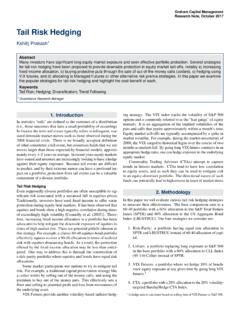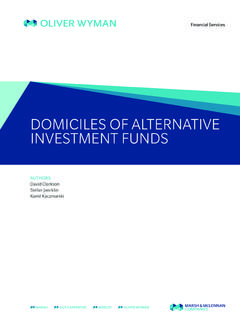Transcription of 2010 11 Global Macro Hedge Fund Investing - …
1 Strategy outperformed the equity market while experiencing an annualized volatility of , sig-nificantly lower than the MSCI The World Index s volatility of Introduction Since the latter half of 2007, a number of signifi-cant macroeconomic factors have dominated the Global investment landscape. What started out as a bursting of the housing bubble in the United States turned into a cascading series of events that eventually threatened the entire Global finan-cial system in 2008 and 2009. At the heart of the financial crisis are several key issues: ill-conceived and poorly constructed finan-cial derivatives products, an overleveraging of consumer and financial institutions, the collapse of the housing market, a slowdown in consumer spending , and a precipitous fall in employment. As a result, many fundamental investment strate-gies based on micro-level analysis of company-specific situations have had their difficulties.
2 During this time, however, one investment strate-gy Global Macro has differentiated itself in terms of both producing positive absolute returns and diversifying the risks of institutional portfoli-os. In fact, over the ten year period ending in Sep-tember 2010, the Dow Jones Credit Suisse Global Macro Index1 posted an annualized return of more than 12%, compared to a annualized return for the MSCI The World Index. The Global Macro October 2010 John Casano, CAIA Senior Consultant, Hedge Funds Global Macro Hedge fund Investing : AN OVERVIEW OF THE STRATEGY AN OVERVIEW There are three primary reasons why Global mac-ro generally has outperformed other investment strategies. Global Macro benefits from a sustained in-creased volatility in currencies, interest rates, commodities, and equity markets. 2. As an investment strategy, it has a low corre-lation to equities.
3 3. It tends to perform well when markets are driven by overall macroeconomic themes ra-ther than by individual bottoms-up fundamen-tal analysis. As a result, Global Macro has produced positive returns when other strategies have been severely challenged. In addition, when added to a portfo-lio where equities are the dominant risk, Global Macro can dampen portfolio volatility, even though it is a relatively volatile strategy when im-plemented independently. The outperformance of Global Macro over the last decade, combined with increasing institutional investor appetite for liquidity, performance, diver-sification, uncorrelated return streams, and trans-parent asset pricing/valuation have highlighted the benefits of this Hedge fund investment strate-gy. ONE OF THE ONLY INVESTMENT STRATEGIES THAT HAS STOOD HAS BEEN Global Macro 1: For the purposed of comparison, we used the Dow Jones Credit Suisse Global Macro Hedge fund Index.
4 While shortcomings associ-ated with Hedge fund benchmark construction and composition exist, we believe that the use of this index represents the broad Global Macro investment set and presents a directionally accurate compari-son relative to other investment benchmarks and strategies. 2: The Dow Jones Credit Suisse Managed Future Index experienced a annualized return and a annualized standard deviation over the ten year period ending September 2010. 2 Nixon announced the temporary suspension of the dollar's convertibility into gold. After an attempt to revive the fixed exchange rates failed in March 1973, major currencies began to float against each other. 4 This untethering of the world s markets created new trading opportuni-ties between different sovereign fixed income and foreign exchange instruments. According to au-thor and industry practitioner Steven Drobny, with currencies freely floating, a new dimension was added to the investment decision landscape.
5 Exchange rate volatility was introduced while new tradable products rapidly developed. 5 Investment managers began to focus on profiting from macroeconomic dislocations that emerged from this latest economic paradigm, and over the next few decades, talented traders generated dramatic profits. For example, Paul Tudor Jones, a discretionary GM portfolio manager (PM), successfully predict-ed and traded on the collapse of the equity mar-kets in 1987. In September of 1992, George Soros forced the British government to pull the British pound from the European Exchange Rate Mecha-nism, and in the process famously made $1 billion breaking the Bank of England. Successful prog-nosticators and the media coverage that followed combined to draw attention and assets into the GM strategy. Strategy Evolution Through time, two major types of GM sub-strategies have evolved.
6 The systematic sub-strategy relies more heavily on computerized al-gorithms to identify market movements and make decisions on buying or selling instruments. The discretionary sub-strategy, on the other hand, relies more heavily on portfolio managers to make those decisions. Both strategies are discussed more thoroughly later in this document, but a brief overview is needed to understand the histo-ry of GM funds. This primer attempts to shed light on Global mac-ro, that has been largely ignored by institutional investors. This document, which is the result of an extensive process that included interviews with practitioners and interaction with the GM Hedge fund community, provides an introduction to and summary of the Global Macro investment landscape. This paper is designed to: Briefly describe the history of the strategy Define Global Macro and its relation to the rest of the Hedge fund universe Break down the strategy into its sub-components for a deeper level of analysis and understanding of how these Hedge funds op-erate History & Strategy Evolution History The Global Macro (GM) strategy s modern roots trace back to the international monetary system s departure from the gold standard, which created trading variables in the fixed income and currency markets.
7 In 1944, the Bretton Woods Conference was held to address the international monetary and finan-cial order following World War II, and, more spe-cifically, to identify a replacement to the gold standard the international monetary regime until that time. The conference resulted in the crea-tion of both the International Monetary fund (IMF) and the International Bank for Reconstruc-tion and Development (IBRD). The latter organiza-tion provided a system of fixed exchange rates backed by the dollar as its reserve currency and encouraged an open system by committing the Allies to both the convertibility of currencies and to free By the early 1960s, many believed that the dollar was overvalued against gold, setting off a series of events described here by the IMF: A sizable increase in domestic spending on Presi-dent Lyndon Johnson's Great Society programs and a rise in military spending caused by the Vi-etnam War gradually worsened the overvaluation of the In August 1971, President Richard Discretionary and Systematic Global Macro 3.
8 The only currency strong enough to meet the rising demand for international currency transactions was the USD because of 1) the economy s strength, 2) the fixed relationship of the dollar to gold, and 3) the commitment of the government to convert dollars into gold. 4. International Monetary fund , About the IMF: History: The end of the Bretton Woods System (1972 81), (September 28, 2010). 5. Steven Drobny, Inside the House of Money: Top Hedge fund Traders on Profiting in the Global Markets (Hoboken, New Jersey, United States: John Wiley & Sons, Inc., 2006, 2009), 7 3 Global Macro s Place in the Hedge fund Industry Figure 1: Hedge fund Strategy Breakdown While there are a number of ways to classify Hedge funds, this paper uses the Dow Jones/Credit Suisse Index ( ) meth-odology. Hedge funds implement strategies and styles that vary widely. As Figure 1 shows, there are 14 general Hedge fund strategies that can be placed into four major categorizations; Direction-al, Event Driven, Relative Value, and Global Mac-ro.
9 Global Macro , often referred to as tactical trading, is a significant component of the overall industry. As we have discussed, it consists of two sub-strategies: Discretionary and Systematic. Size of the Hedge fund Industry & the Glob-al Macro Hedge fund Strategy While registration and reporting are not mandato-ry in the Hedge fund industry, data from Hedge fund Research Inc. (HFR) serves as a proxy for overall marketplace trends. The HFR Database indicates that the peak of total assets for all Hedge funds was reached at the end of 2007 at $ trillion. After assets fell by 25% to $ trillion at the end of 2008, asset levels rebounded to $ trillion at the end of 2009 for the 9,050 Hedge funds reporting data to Both the discretionary and systematic Global mac-ro sub-strategies have changed dramatically over time as a result of evolving market opportunities and investor demand.
10 Originally, PMs predomi-nantly traded foreign exchange currencies and fixed income instruments by placing directional trades making outright bets on the future move-ments of these markets. Likewise, some firms cre-ated computer programs (trading systems or models) to identify and exploit long-term price trends in markets. Discretionary firms that origi-nally opened with a focus on the principal s gen-eral area of expertise broadened their investment scope as more capital, markets, and opportunities became available. They began to target opportu-nities outside their original fixed income and for-eign exchange asset classes. In addition to out-right directional bets, PMs placed relative value trades to take advantage of the mispricing be-tween two similar instruments. Systematic firms, in an attempt to lower the volatility of their re-turns, began to employ new computerized mod-els, designed to capture markets reverting to a natural equilibrium, in addition to their original models focused on capturing longer-term trends.












